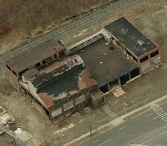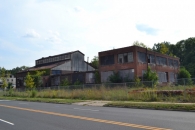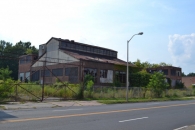Mill Record Hartford
RETURN TO ‘FIND MILLS’Disclaimer: Content for these properties was compiled in 2014-2017 from a variety of sources and is subject to change. Updates are occasionally made under Property Information, however the Connecticut Trust for Historic Preservation (dba Preservation Connecticut) makes no representation or warranty that the information is complete or up-to-date.
- Complex Name (Common)
- Hartford Empire Co., Experimental Development Plant DEMO’d 2018
- Complex Name (Historic)
-
- Hartford Empire Co., Experimental Development Plant
- Address or Location
- 393 Homestead Avenue, Hartford
- County
- Hartford
- Historic Designation
- Associated Mill Community
- n/a

- Historic Information
Companies Associated w/Complex
- Emhart Manufacturing Co. 1951-1962
- Hartford Empire Co. 1929-1951
Use (Historic)
Largest Documented Workforce
Unknown for facility; 32,000 g
Historic Narrative
The origins of the Hartford Empire Company can be traced to Hartford, Connecticut in 1910. It was that year that a small mechanical engineering shop operated by William A. Lorenz and William H. Honiss was contracted to assist the Beech-Nut Packing Company of Canajoharie, New York, in developing machinery that would allow glass manufacturers to produce jars and tumblers that could hold up to the vacuum sealing processes employed by the company. Under this contract, an engineer in the employ of Lorenz and Honiss by the name of Karl E. Peiler succeeded in developing an automatic machine that revolutionized the glass-forming process. A patent for the device was secured and in 1912 the Hartford Fairmont Company was organized for its production. Among the directors of the Hartford Fairmont Company were Bartlett Arkell, president of the Beech-Nut Packing Company; H.L. Heintzelman, president of the Monongah Glass Company of Fairmont, West Virginia; and numerous Hartford representatives, including Lorenz, Honiss, and Peiler. The manufacture of glass-making machinery and glassware by the Hartford Fairmont Company initially took place at the firm’s plant in Fairmont, West Virginia, however, machinery production was moved to Arch Street in Hartford, in 1916. In 1918, the company erected a new factory at 333 Homestead Avenue in order to develop and manufacture a full line of glass-forming machinery. The Hartford Fairmont Company was reorganized as the Hartford Empire Company in 1922 after the firm acquired control of patents held by the Empire Machinery Company, a division of the Corning Glass Works of Corning, New York. Peiler served as the company’s chief engineer and oversaw development and production of the firm’s ‘Hartford Glass Working Equipment,’ which became an industry standard. In 1929, the firm announced plans to erect an experimental materials plant, which would be located on Homestead Avenue some 500’ north of the company’s main factory. Like the primary plant, the experimental materials building was expanded several times as the Hartford Empire Company grew into the largest manufacturer of glass-making machinery in the country during the 1930s. In 1939, the firm’s dominant position drew the attention of the Federal Government, which implicated the Hartford Empire Company along with the Owens-Illinois Glass Company of Ohio in an anti-trust suit claiming that through patent licensing agreements the two firms controlled 97-percent of glass container production in the United States. The Hartford business was managed under a receivership until 1946, whereupon the company was reorganized and a board of managers entirely comprised of Hartford representatives was elected. Despite the restructuring, the Hartford Empire Company remained the preeminent manufacturer of glass-forming machinery in the United States and in 1946 70-percent of all glass containers produced in the country were made with Hartford equipment. Management conducted an aggressive series of mergers and acquisitions throughout the 1940s, and in 1951 was reorganized as the Emhart Manufacturing Company in an effort to better reflect the diverse array of product and machine tool capabilities possessed by the firm by the time. In 1961, the Emhart Manufacturing Company built a new facility in Bloomfield, Connecticut. Although initial reports stated that the firm’s two plants on Homestead Avenue in Hartford would not be impacted, use of the buildings was discontinued the following year. Emhart Manufacturing merged with the American Hardware Corporation to form the Emhart Corporation in 1964, which boasted peak global employment of 32,000 workers. The company was divided and various pieces sold off after being acquired by Black and Decker in 1989, however several divisions, including Emhart Teknologies of Shelton, Connecticut, and Emhart Glass of Windsor, Connecticut survive either independently or under corporate ownership.
- Architectural Information
Number of Existing Buildings
Four (4) adjoining primary blocks.
Dates of Construction
1929, 1933, 1938, 1939.
Architect
Mylchrest and Reynolds
Builder
n/a
Building Type
Architectural Description
The former Hartford Empire Company’s experimental development facility is comprised of four adjoining blocks located on the west side of Homestead Avenue, opposite Homestead Avenue’s intersection with Baltimore Street. The original portion of the plant was built in 1929 and consists of a one-and-a-half-story, 75’ x 75’ steel-frame block with red brick and concrete panel walls, and a side-gabled roof with a tall clerestory monitor. Large rectangular window openings are located on the blocks’ east (front) and south (side) elevations, these with brick sills and multi-pane metal sash with hopper-style openings. Three additions to the facility were completed between 1933 and 1939. A one-story, 62’ x 86’ steel-frame and red brick addition was erected adjoining the north elevation of the original block in 1933. This has large rectangular window openings with brick sills, multi-pane metal sash with hopper-style openings, and a flat roof. A two-story, 75’ x 30’ red brick block adjoins the west (rear) elevation of the original mill. This was built in 1938. It has a concrete foundation, large rectangular window openings with concrete sills, multi-pane and glass block windows, a brick parapet with tile coping, and a flat roof. The final addition to the plant was completed in 1939. This is a two-story, 33’ x 86’ red brick block adjoining the north elevation of the 1933 addition. It is identical in detail to the 1938 addition. Designed by the notable Hartford architecture firm of Mylchrest and Reynolds, it was constructed at a total cost of roughly $20,000.
Exterior Material(s)
Structural System(s)
Roof Form
Roof Material
Power Source
Condition
Fair
Condition Notes
The complex is in deteriorated condition. The exterior walls and roofs are in dire need of repairs and many of the windows are broken, missing, or boarded over. DECD awarded $1.9 million grant to demolish and remediate 367, 393 and 424 Homestead Ave Nov 2017.
- Property Information
-
Specific Location
One legal parcel (393 Homestead Avenue) totaling 1.19 acres located on the west side of Homestead Avenue, opposite Homestead Avenue’s intersection with Baltimore Street.
Adjacent To
Exterior Visible from Public Road?
Yes
Parcel ID / Assessor Record Link
- 153/181/007 (for record, use link and type in address or parcel number) / Link →
Acreage
1.19
Use (Present)
- Sources
-
Form Completed By
Lucas A. Karmazinas
Date
08/31/2015
Bibliography
- List of Connecticut Manufacturers, 1922, 1924, 1930, 1932.
- Directory of Connecticut State Manufacturers, 1936, 1939.
- Industrial Directory of Connecticut, 1947.
- Register of War Production Facilities in Connecticut, 1951.
- Map of Hartford County, H & C.T. Smith, 1855.
- Atlas of Hartford County, Beers, Baker & Tilden, 1869.
- Sanborn Map Company, 1885, 1900, 1917, 1920, 1923, 1950.
- Aerial Survey of Connecticut, 1934, 1965.
- Hartford City Directories, Various editions.
- The Hartford Courant, 1920, 1929, 1930, 1933, 1938, 1939, 1940, 1946, 1964.
- Representative View(s)Click on image to view full file






